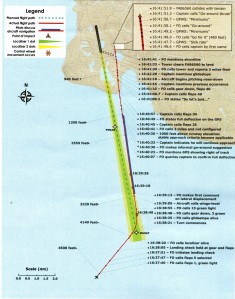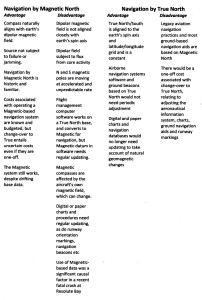Airline pilots today are obliged to steer their machines according to an instrument discovered in the earth’s Iron Age: the magnetic compass. Ships’ commanders only use that these days if all else fails.
By modern navigation standards the magnetic compass is not an accurate device. An aviator flying along a magnetic meridian toward either the North or South Magnetic Pole flies “a wiggly track” according to the Geomagnetism Team of the British Geological Survey. The pilot’s magnetic compass may display a constant heading, but the aircraft relying on it follows the gently wandering vagaries of the earth’s dipolar magnetic field.
In 2011 a Boeing 737 suffered a fatal crash on approach to land because of the artificially-induced complexities of a navigation system based on Magnetic North in a digital era (detail later). All four crew and eight of the 11 passengers were killed.
Modern aviation navigation can be conducted using a phenomenally accurate, multi-sensor system orientated to the earth’s spin axis, with reliable integrated backups. But in fact it’s compromised by the decision to continue using a legacy system of orientation based on the earth’s ever-changing magnetic field.
This dependency on steering by the earth’s dipolar magnetic field when technology provides far better alternatives is enforced by institutions like the International Civil Aviation Organisation and the International Air Transport Association which are content with the status quo.
For the time being at least.
ICAO’s maritime sibling, the International Maritime Organisation, approved navigation by True North/South beginning in the late 1970s, and now it is universal for all but a few coastal mariners who choose not to use GPS backed up by inertial navigation systems (INS). Now the IMO is in the final stages of implementing standards for what it calls “e-navigation”, its way of describing the use of the best available integrated digital, satellite and other technology, plus best practice, to achieve the most accurate and reliable navigation at sea, all with the earth’s spin axis as the directional orientation reference.
ICAO itself, on the other hand, commented recently: “This issue [navigation by True North] is not on our work programme at present.”
Asked for a comment on the situation, the UK CAA said: “We understand the issue, and with the increased use of GPS etc., moving to True North does make more sense. Also as more aerodromes look to formalise GNSS (global navigation satellite systems) approaches the logic is clear.”
So why not adopt True North? It’s not the CAA’s job to make this decision (rather it’s for ICAO and EASA), but the CAA slightly apologetically offered this explanation on behalf of the international aviation establishment: “If you were starting from a blank sheet of paper with the technology available today, you would select True North. But aviation started with magnetic from the outset. The infrastructure supporting aviation is also based on magnetic, including VORs, runway directions, approach procedures, radar etc.”
ICAO and IATA argue that navigation by magnetic track still works, so there’s no need to face the effort and cost of moving to an orientation system based on Earth’s spin axis (True North/South) despite the fact that the cost of changeover would be one-off.
Maintaining the existing system, which requires regular updating as the earth’s two magnetic poles constantly migrate relative to the geographic North and South Poles, has a continual cost, but that’s apparently fine because it’s built in to the system’s budget, so no new decisions need to be made.
Magnetic navigation is fine as a backup system – and nobody doubts that every aircraft will continue to carry a standby magnetic compass in the cockpit as long as manned flight lasts. The IMO requires all ships to have a magnetic compass, but to steer by a system using True North.
Maps and charts are oriented according to the earth’s spin axis – True North/South. This is also the orientation datum programmed into the firmware of the aircraft flight management computers (FMC). They have to convert their orientation information to Magnetic to pass it to the avionics displays, unless the pilots choose to select True, which, of course, they can. But air traffic management protocol requires them to use Magnetic when operating under instrument flight rules (IFR).
Air traffic controllers still pass magnetic headings for pilots to steer for procedures and traffic separation purposes. Pilots still navigate by adopting Magnetic headings which are actually converted from True by the FMS and shown on their compasses in the primary flight display/navigation display.
The FMS does this by applying a “variation” between Magnetic and True that was embedded in the firmware when the system was set up.
This variation value needs to be updated regularly, but it rarely is, despite the fact that, in the last 40 years the rate of migration of the Magnetic North Pole (MNP) has accelerated dramatically. FMS software is easily updated, but firmware is more of a problem.
In fact the surface position of the MNP is forecast to reach its closest point relative to the Geographic North Pole (GNP) in 2020 (approximately 87N 170E), and then it will continue moving tangentially past the GNP toward Russia’s north coast. Therefore the so-called magnetic heading most aircraft are flying is inaccurate because the variation value – in many fleets – has not been updated since the FMS was new.
THE RESULTING FATAL CRASH
As a result of this built-in disparity, in 2011 an airliner fatally crashed into high ground because the pilots were confused by an inaccurate compass heading.
On 20 August 2011 the crew of the Bradley Air Services Boeing 737-210C (C-GNWN) were attempting an instrument landing system (ILS) approach to the airport at Resolute Bay, Nunavut, in Canada’s far northern islands, somewhat closer to the Magnetic North Pole than most aviators usually get to fly. The airfield and approach charts – and therefore the procedures – show True North for orientation. This is customary in polar regions because the magnetic field lines close to the Magnetic North Pole have a strong vertical component, so the lateral strength of the field reduces. Meanwhile the variation can be enormous.
The Resolute Bay ILS approach that day was to runway 35T, the localiser orientated to 347degT. The magnetic variation at Resolute Bay at the time was 28degW.
The autopilot was initially set to VOR/LOC Capture, and the compass system set to True, but according to the Transportation Safety Board of Canada (TSBC) report there was a compass error. The captain was flying 330degT according to the heading on his horizontal situation indicator (HSI), perceiving the intercept angle to be 17deg from the right of the localiser (347T).
The report explains: “However, due to the compass error, the aircraft’s true heading was 346deg. With 3deg of wind drift to the right, the aircraft diverged further right of the localiser. The crew’s workload increased as they attempted to resolve the ambiguity of the track divergence, which was incongruent with the perceived intercept angle and expected results.”

Diagram from TSBC report
This is what happens when pilots don’t know what to believe, and in a region where there are three Norths – Magnetic, True, and Grid (the latter for local charts), confusion is the default when things don’t proceed as expected.
The crew were indeed confused and decided to abandon the approach, but just as they were initiating the go-around the 737 flew into a snow-covered rocky hilltop about a mile east of the airfield. It didn’t help that the aircraft was fitted with an old fashioned – rather than an enhanced – ground proximity warning system, and that the crew were under additional pressure because they began the descent well above the glideslope.
Spurred by this event, at ICAO’s Air Navigation Conference in November 2012 Nav Canada proposed that aviation should stop using magnetic references and use only directional orientation relative to the Geographic North Pole.
This makes particular sense for any country – like Canada – with territories that approach the arctic or antarctic regions, who are forced to use True close to the magnetic poles, but it would also work perfectly worldwide. But the Montreal-headquartered ICAO has still not put the issue on its “to do” list.
Now, however, with more flights than ever transiting the Arctic ocean on routes between North America and South East Asia or India, steering by Magnetic North makes little sense, although it just happens that the Magnetic North Pole is now migrating closer to the Geographic North Pole than it has ever been in recorded history.
That imminent closeness of the two North Poles is used by the pro-True lobby to suggest this is a natural time to change, because the changes required will be the smallest they have ever been. But it is change itself that presents the one-off cost, and which demands scarce human resources to organise it, not the mathematical size of the variation between Magnetic and True.
The following rather simplified chart shows that the advantages – in today’s world – of Magnetic are few, and the disadvantages many and compelling, while the advantages of True are powerful and its disadvantages relatively trivial.

Maybe at present there is no actual urgency to adopt True North as aviation’s navigation lodestar, but industry voices on the subject are muted, as if it is bad form to step out of line.
A major European airline, not alone in its beliefs, has a compelling and detailed presentation on the subject, in which it concludes : “Transition from magnetic to true reference is unavoidable. The transition phase will need further studies in order to maintain the safety objectives. Time is ripe to start the transition process.” But the carrier was not prepared to break cover.


